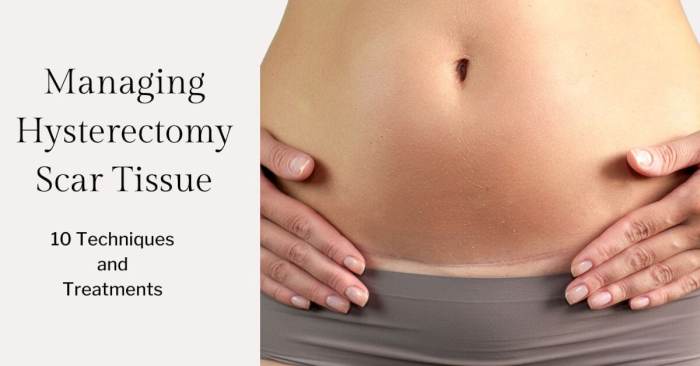Managing Hysterectomy Scar Tissue: 10 Techniques and Treatments
After my hysterectomy, I felt a mix of relief and concern. The thought of having scar tissue from the surgery worried me. I wondered if it would affect my movements, cause discomfort, or disrupt my daily life.

This blog is reader-supported. When you buy through a link on our site, we earn a commission at no extra cost to you. Read more
Like many of you, I wanted a healing process that could be as private as possible. I hoped to minimize any reminders left on my skin. It wasn’t just about recovering physically but also about healing emotionally and psychologically.
After such a significant change, you’re likely eager to move forward, feel whole again, and regain confidence in your body. The challenge of managing and reducing scar tissue extends beyond the physical; it touches on your emotional and psychological well-being. Following your hysterectomy, you’re on a journey to nurture your body and rediscover your inner strength and well-being.
Remember that scar tissue, although a natural part of healing, can cause inconvenience if it becomes excessive. It might lead to stiffness, discomfort, and noticeable changes in appearance. That’s why addressing your recovery’s aesthetic and functional aspects is essential.
In this guide, I explore various techniques and treatments specifically designed to tackle issues related to scar tissue following a hysterectomy, all to facilitate a smoother healing process. Let’s dive into these methods, finding the best ways for you to heal both physically and emotionally.
Read also: A hysterectomy incision sucks, but you should probably know more about it.
Managing and reducing scar tissue post-surgery:
Techniques and treatments to manage and reduce scar tissue formation post-surgery.
1. Hysterectomy scar tissue massage therapy
Massage therapy involves applying gentle pressure and movement to the scar area. This technique can help by:
2. Silicone Gel Sheets
A silicone gel sheet is a non-invasive treatment that involves placing a thin sheet of silicone gel over the scar.
They work by:
Hydrating the scar tissue to prevent the scar from becoming too raised or red.
Providing a protective barrier that can reduce the likelihood of irritation from clothing or the environment.
Flattening and softening the scar over time, making it blend more with the surrounding skin.
3. Steroid Injections
It is common to inject steroids into hypertrophic or keloid scars, which are raised and can be itchy or painful. These injections can:
4. Laser Therapy
Laser therapy uses focused light to target and improve the appearance of scars by:
5. Physical Therapy

Physical therapy involves exercises and stretches specifically designed to improve movement and flexibility in areas affected by scar tissue, such as:
6. Hysterectomy Scar Tissue Removal
When scar tissue severely impacts function or appearance, such as with a hysterectomy scar overhang, surgical removal is an option. This process involves:
7. Immediate Wound Care
Proper initial care is crucial for minimizing scar formation and involves:
8. Pressure Garments
Wearing pressure garments can be particularly effective for large wounds or after burn injuries, as they:
9. Hydration and Nutrition
Optimal hydration and nutrition play a vital role in the body’s ability to heal, including:
10. Avoiding Sun Exposure
Protecting the scar from the sun is important because:
By understanding and applying these techniques and treatments, individuals can significantly improve their recovery and the appearance of scars following surgery.
FAQs about Scar Tissue Management
It’s essential to wait until the wound has healed and your doctor gives the go-ahead. Depending on the individual case, this is typically a few weeks after surgery.
Yes, herbs like aloe vera and honey and essential oils like lavender and tea tree oil promote healing. However, it’s important to discuss these with your doctor before use.
While removing scars completely is difficult, effective management can significantly reduce their appearance and prevent complications related to mobility and discomfort.
The duration varies depending on the severity of the scar and the techniques used. Some may require ongoing treatment for several months to a year.
Some treatments, like massage therapy and physical exercises, might cause discomfort initially but should not be painful. Always communicate with your healthcare provider if you experience pain during treatment.
After surgery, scar tissue can form on the skin’s surface or within the body. Due to this hysterectomy scar tissue, some women may experience pain, tightness, itching, or difficulty moving. These symptoms may not manifest until years after the initial injury because scar tissue matures over time. The best recommendation is that if you experience movement impairment or severe pain resulting from scar tissue, speak to a doctor to explore your options.
To wrap it up
Navigating the journey of scar tissue management takes time and steady effort, but rest assured, it’s a path toward significant improvement. With a thoughtful blend of techniques and treatments, you can greatly enhance the look of your scars and support your body’s recovery after surgery.
It’s important to remember that you’re not alone in this process. With the help of a healthcare professional, you can develop a scar management strategy that’s tailored just for you and aligns with your unique healing needs.
As we reach the end of our guide on managing hysterectomy scar tissue, it’s clear that while the journey can be complex, it’s also filled with hope and potential for healing. We’d love to hear from you—what has been your experience with scar management?
Do you have any tips or stories of recovery that could inspire others?
If you have any thoughts or questions, please share them below.
Your insights enrich our community and offer support and encouragement to those walking a similar path. Let’s continue to learn from and support each other in our healing journeys.


